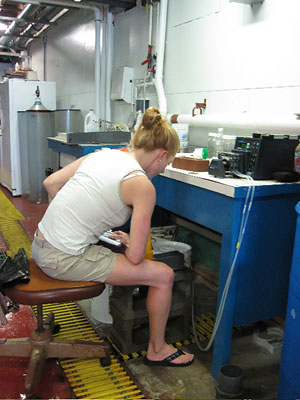

 | |||||||||
|
|
Journals 2009/2010Jennifer Emblidge
August 17, 2009 Today was full of lots of surprises for us! It started off with bad news though. We entered the lab in the morning to find out that the tank that was holding a lot of the lab's stage 4 lobsters had overflowed in the middle of the night. For some unknown reason it got clogged and backed up, so a lot of baby lobsters were lost! Well, at least at first glance it looked like a lot were lost, but after Lee played search and retrieval for them in the tanks below, it really wasn't too bad...so that was a good surprise! Next, we had a lab meeting at 8:30 a.m. That was a surprise to me! I did not check my e-mail the night before to get the notice. The meeting was planned in order to go over our hectic schedule for the week. In order to make it less confusing for everyone, Rick divided the lab into two teams. One team, Charlene and Lee, would focus in the lobster experiments and the other, made up of Mahima and Katherine, would focus on the scallops. Since my stay in the lab is so brief, I was asked to help where I was needed. Today, I was to help Jana with her lobster experiments. We were also asked to prepare for the trips to Rockland and Stonington for the weekly monitoring and for next week's release here in the Damariscotta River. The lab decided that they wanted to tag the stage 4 lobsters that they release next week. In order to tag such a small organism, they are going to order elastomer tags. The tags will be used in order to determine if the lobsters they see in the river were raised in the lab or are wild. An elastomer tag is a plastic dye that is injected under the translucent abdomen of the baby lobster. When the lab recaptures the lobster during their weekly monitoring, it will have an abdomen that will be a fluorescent color when viewed under ultraviolet light. At the conclusion of the lab meeting, I started the lobster trials for Jana. Today, we were using her flow unit in order to determine if lobsters prefer to travel towards water that has been exposed to predators or unexposed seawater. It is assumed that they are using their keen sense of smell to distinguish between the predator exposed water or the natural seawater. The until was set up to a flow meter that made sure equal amount of both types of seawater were sent down both sides of the unit. First, I placed a stage four lobster in a cage at the end of the unit. I let the lobster acclimate to these conditions for three minutes. Then, I released the lobster and recorded where it traveled in the unit. I entered abbreviations into a data table that would allow Jana to see how much time the lobster spent traveling towards each water type. I recorded the lobster behavior for ten minutes. I did this with a total of ten lobsters. That was just the first trial! For the second trial, I switched the tubes so the water types were on different sides and I repeated the entire experiment with the ten lobsters. This took me six hours to complete.
I thought I would take this time to introduce you to another person in the Wahle lab. Today, you will meet Katherine Thompson. Katherine is an intern in the Wahle lab this summer. She is the resident lab expert on scallops because she has spent a lot of time working with them. While I was interviewing her, Katherine was gluing together PVC piping with mesh that will be used as scallop egg filters. Katherine plans to apply to marine biology graduate schools this winter. She may try to continue her shellfish studies in graduate school. She has her undergraduate degree in biology from Smith College in Northampton, MA. Currently she is living in Damariscotta but she grew up in the neighboring town of New Harbor, ME. Katherine's main role in the lab is to help design the protocols for the scallop experiments. Currently, they are working on five major experiments. In the sperm and egg viability experiments they will be examining the duration of scallop gamete activity. The spawning rate experiments will be used to look at the numbers of eggs that a female scallop releases over time. The sperm dilution experiments will be used to determine the optimum sperm concentration for fertilization. Finally, the temperature dilution experiments will be used to determine the optimal temperature for fertilization. When Katherine was asked about her favorite part of her job, she replied that she truly enjoys working with scallops. Compared to her previous job working at an oyster farm raising oysters, scallops were much more fun and exciting. She thinks that scallops are very active creatures and she enjoys the fact that they are a challenge to work with. Her least favorite part of the job was the sometimes difficult and demanding hours she spent working in the lab. The last surprise of the day occurred at 5:30 p.m. when Rick entered the lab and asked all of us if we wanted to participate in some oceanography studies. Oceanography studies means that we put some skis on our feet and go observe the water as the boat pulls us over it. If you didn't get it yet...this means that we got to go water skiing. This was a perfect conclusion to our day since it was the hottest day of the summer! The only challenge to the skiing was maneuvering around all the lobster pots in the river. |
||||||||
